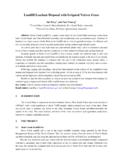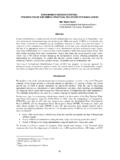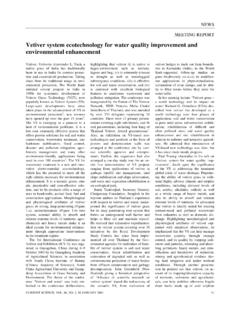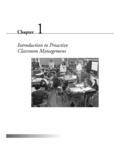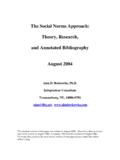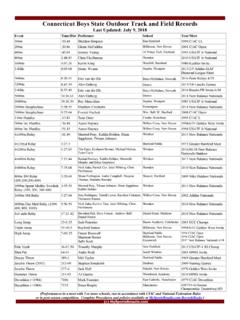Transcription of Vetiver Oil and Its Sedative Effect
1 492 Vetiver Oil and Its Sedative EffectSirinan Thubthimthed, Krittiya Thisayakorn, Ubon Rerk-am,Sinn Tangstirapakdee, and Taweesak SuntorntanasatThailand Institute of Scientific and Technological Research (TISTR, Bangkok, ThailandAbstract : The essential oil obtained by steam distillation from the roots of Vetiveria zizanioides (L.)Nash was investigated for their chemical constituents by GC and GC/MS. The major volatile componentsbelong to the sesquiterpene group such as khusimol, a-vetivone, and b-vetivone. The Sedative Effect ofvetiver oil upon inhalation in rats was studied by observing the number of crossing and rearing results showed that Vetiver oil decreased rearing motility when compared to the control words: Vetiver oil, Sedative Effect , khusimolEmail contract: Sirinan Thubthimthed INTRODUCTIONThe essential oil of Vetiver , Vetiveria zizanioides (L.))
2 Nash is one of the most important rawmaterials in perfumery both as a fixative and in its own right as a fragrance ingredient. It has extensiveapplications in toiletries and cosmetic industries and Vetiver root is also important in traditional medicineas a carminative, stimulant and oil possesses Sedative property and has been traditionally used in aromatherapy forrelieving stress, anxiety, nervous tension and insomnia for a long time (Fischer-Rizzi, 1990). However,there is a lack of scientific experiment to prove these effects by way of inhalation. The aim of this studywas to investigate the oil yield and chemical composition from the roots of Vetiver cultivated in Thailandand to determine the Sedative Effect of Vetiver oil upon inhalation in MATERIALS AND Plant MaterialVetiver, Sri Lanka ecotype was cultivated by the Agricultural Technology Department, TISTR, atLam Takhong Research Station, Nakhon Ratchasima Province, in the Northeast of Isolation of the Essential OilThe dried roots were subjected to steam distillation for 14 hours.
3 The isolated oil was dehydratedby addition of anhydrous sodium sulfate and kept in an amber-colored glass bottle. The oil yield wascalculated relative to the dry AnalysisVetiver oil was investigated using capillary Gas Chromatography (GC) and GasChromatography/Mass Spectrometry (GC/MS).GC analysis was performed using a Fisons gas chromatograph model 8000 series equipped with aFID detector and a DB-5 capillary column (30 m mm; film thickness mm). The operating493conditions were as follows; carrier gas: helium with a flow rate of 2 ml / min; column temperature: 50 -220 oC at 4 oC / min : injector and detector temperatures: 230 analysis was performed on a VG Quattro mass spectrometer operating at 70 eVionization energy, equipped with a DB-wax column (60 m x mm x mm).
4 The oven temperaturewas programmed from 35 oC (5 min) to 220 oC (45 min) at 3 oC/min, with helium as carrier gas. Theidentification of the oil components was accomplished by comparing their GC retention indices as well astheir mass spectra with corresponding data of authentic compounds or published spectra (Heller andMilne, 1978,1980,1983; Adams, 2001). Animal StudyMale Wistar rats with mean body weights of 124 g were divided into 3 groups (7 rats/group) andkept under conventional conditions at room temperature of 24 oC. The first group was used for testingwith Vetiver oil (5 % w/w) and the others with lavender oil (5 % w/w) and distilled water as a positivecontrol and control group, respectively. The cage for inhalation (14 L) contained a perforated plastic,which was partitioned into two sections.
5 One part contained soda lime (14 g) to absorb CO2 and the otherone contained calcium chloride (14 g) to remove humidity. After each group of animal was put into thecage, it was made airtight with a transparent plastic seal with 2 small openings. One was connected to aspirometer for O2 admission. The second was fitted with a folded 8x10 cm filter paper, which was used toadd the volatile open-field test was modified from Brotto and Kovacs (Brotto, et al., 2000, Kovacs, et ,1999). After the animals inhaled the essential oils for 1 hour, they were rested for 30 minutes. Rats wereplaced individually in the center of a square measuring 10 x 10 cm each. The standard source ofillumination was 60 W bulb from 80 cm. The activity was assessed during 5 minutes and recorded on aceiling mounted video camera.
6 Videotapes were later scored and measured for the number of segmentscrossed by the animal (defined as at least three paws in a quadrant) and the number of rears (defined asthe animal standing upright on its hind legs).Table 1 Composition of Vetiver oil( Sri Lanka ecotype)3 RESULTS AND DISCUSSIONThe steam distillation of dried roots of Vetiveria zizanioides(L.) Nash gave viscous light-brown oil in about - % v/wyield with balsamic earthy and sweet woody odor. The complexmixture of Vetiver oil was identified and summarized in Table the results, it can be seen that sesquiterpenes constitute thepredominant class of compounds, with khusimol( ),longipinene ( %), valerenol ( %), epizizanal ( %), a-vetivone ( %) and b-vetivone ( %) being the major is a sesquiterpene alcohol which was found to inhibitthe binding of vasopressin to rat liver.
7 (Rao, 1994). Furthermore,khusimol, epizizanal, a-vetivone, and b-vetivone were found topossess insect repellent properties (Jain et al., 1982) , 2 Effect of Vetiver oil administration on crossing and rearing behaviors in the open-field testin ratsNumber of CrossingNumber of MotilityMean% MotilityVetiver animal study explored the Effect of Vetiver oil on the motility of rats using inhalationprocedure. The influence on motility is calculated to demonstrate Sedative Effect after aromatherapeuticalapplication of the essential oils. In this study we used lavender oil, known to have potent Sedative Effect ,as a positive control. (Buchbauer et al., 1993). After the one-hour inhalation period, Vetiver oil led to themost decrease in rearing motility compared to the control group and lavender oil but a small increase incrossing motility.
8 These data showed that Vetiver oil possesses sedation Effect in agreement withtraditional use. In order to understand the Effect of every major component of Vetiver oil, it may benecessary to study their activities individually on the animals authors would like to express their thanks to Dr. Joseph J. Brophy, School of Chemistry,University of New South Wales, for assistance in the GC/MS R. 2001. Identification of essential oil components by gas chromatography quadrupole massspectrometry. Allured publishing Corp., Carol Springs, ILBrotto LA, et al. 2000. Sex differences in forced-swim and open-field test behaviours after chronicadministration of melatonin. Eu. J. Phar., 402: 87-93 Buchbauer G, et al. 1993. Fragrance compounds and essential oils with Sedative effects upon Pharm.
9 Sc. 82(6): 660-664 Fischer-Rizzi S. 1990. Complete aromatherapy handbook: essential oils for radiant health. SterlingPublishing Company, New York. 178-181 Heller SR, and Miline GWA. 1978, 1980, 1983. EPA/NIH Mass Spectral Data Base, GovernmentPrinting Office, Washington SC, et al. 1982. Insect repellents from Vetiver oil:I. Zizanal and epizizanal. Tet. Lett. 23(45): 4639-4642 Kovacs A, et al. 1999. Neurotransmitter-mediated open-field behavioral action of CGRP. Life Sciences,64(9): 733-740 Kovar KA, et al. 1987. Blood levels of 1,8-cineole and locomotor activity of mice after inhalation andoral administration of rosemary oil. Planta Med. 315-318 Rao RC, et al. 1994. Khusimol, A non-peptide ligrand for vasopressin V1a receptors. J. Nat. Prod., 57(10):1329-1335

